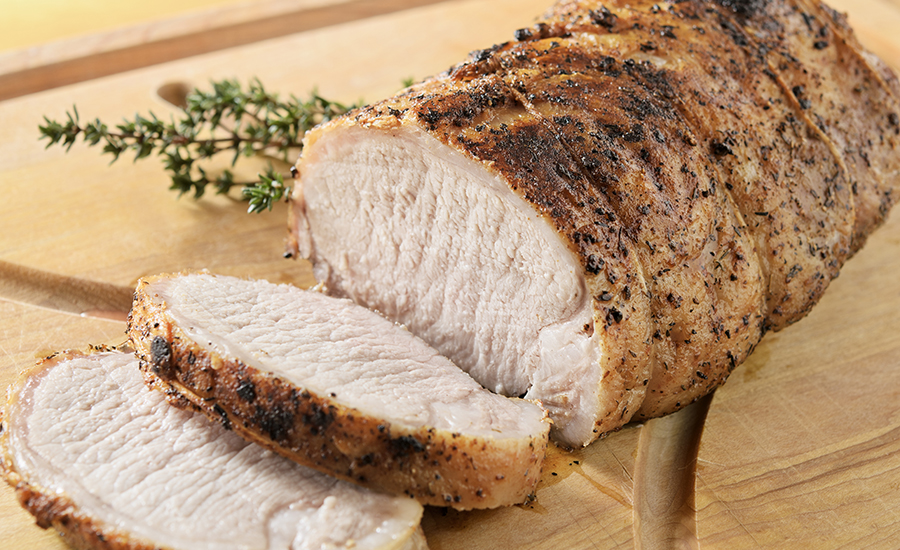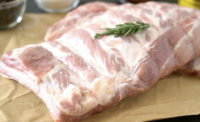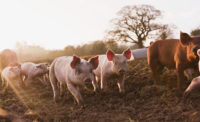U.S. pork production is forecast to hit 27.2 billion pounds for 2023, according to the U.S. Department of Agriculture’s November 2023 U.S. red meat and poultry forecast, marking a slight increase from USDA’s 2022 production total of just under 27 billion pounds.
The agency sees this upward production trend continuing through 2024, with pork production predicted to exceed 27.7 billion pounds for the year.
USDA market research suggests a similar upward trajectory for U.S. pork exports, with 2023 predicted to surpass 6.7 billion pounds (up from more than 6.3 billion pounds in 2022) and increasing again in 2024 to just under 7 billion pounds.
At retail, pork sales trends have been marked by declines. For the 52 weeks ending Oct. 29, 2023, fresh pork sales weighed in at $6.9 billion, a decrease of -5.4% from the previous year at the same time, according to Circana market research. Pounds sold for fresh pork were down -3.6% for that time period, as well.
For processed pork products, breakfast sausage, dinner sausage and smoked ham all enjoyed modest growth in sales for the 52 weeks ending Oct. 29, 2023, with breakfast sausage sales coming in at $2.2 billion (up 0.5%), dinner sausage sales at $4.9 billion (up 1.3%) and smoked ham sales at $1.6 billion (up 2.6%). All three product categories saw pounds sold fall for that timeframe – down -1.3%, -0.6% and -1.2%, respectively.
For bacon, sales for that time period were $5.9 billion, down -8.2% -- while pounds sold grew slightly at 0.5%.
“When it comes to pork products, bacon continues to be a perennial favorite among consumers,” said JD Enrici, vice president of sales and marketing for Coleman Natural Foods. “We have seen growth in demand for Coleman Natural Food products such as Hickory and Applewood-Smoked Bacon.”

Enrici said fall and winter typically see the highest demand for pork due to the number of holiday eating occasions that feature pork dishes, such as ham and pork belly, adding, “Despite inflation’s effects on other meat category prices, pork has declined in cost over the last 12 months; this could help boost demand even more than typical years.”
Enrici said Coleman Natural Foods is working to expand its bacon portfolio, as well as looking at new cuts and products that can meet consumer demand for new flavors and global cuisines that highlight pork’s versatility, from pork belly in ramen to ground pork for dumplings and stir-fry dishes.
“Market research firm Datassential highlighted pulled pork as one of the top flavor trends this past summer, and we anticipate seeing that carry into the fall and winter as consumers seek out more savory, hearty dishes,” he said. “With inflation creating a higher cost in other meat categories, pork has remained steady and has been, and is, a cost-effective option consumers consider more often. It is also a versatile protein that is easy to prepare.”
Enrici said increased interest in global cuisines, new cooking methods and food hacks, and recipes driven by social platforms like Instagram mean that consumer food trends are evolving faster than ever before.
“Smoked and spicy are two big flavor profiles that have continued to generate high consumer interest,” Enrici said.
He said an emerging consumer trend for pork is the increasing importance of animal welfare when it comes to purchasing decisions.
“It’s clear that consumers are taking a more thoughtful approach to buying meat, including pork -- 49% report making an effort to buy from companies that care about animal welfare, according to the Power of Meat report from the North American Meat Institute and FMI,” he said. “As consumers become more educated and engaged on where their food comes from, we are seeing strong demand for all-natural products that are free from antibiotics, hormones, and artificial ingredients. Sales of meat with antibiotic-related claims remained strong over the past year.”
Relatedly, he said, one of the biggest developments has been Proposition 12 in California, which bans the practice of confining pregnant sows in gestation crates.
“We were one of the first national producers to be crate-free, ensuring our hogs are raised in environments that eliminate confinement and allow animals to express normal behavior, with ample space to move during gestation and after giving birth,” he said.

.png?height=96&t=1647275041&width=96)



Report Abusive Comment